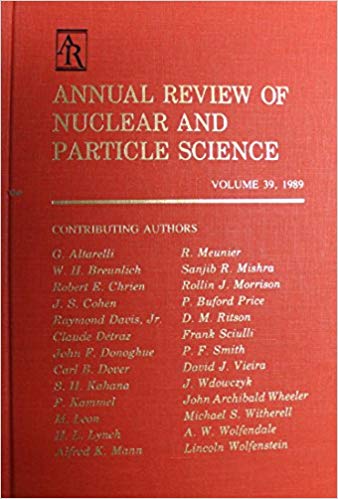Primordial Black Holes as Dark Matter: Recent Developments
IF 8.4
2区 物理与天体物理
Q1 PHYSICS, NUCLEAR
Annual Review of Nuclear and Particle Science
Pub Date : 2020-06-03
DOI:10.1146/annurev-nucl-050520-125911
引用次数: 780
Abstract
Although the dark matter is usually assumed to be made up of some form of elementary particle, primordial black holes (PBHs) could also provide some of it. However, various constraints restrict the possible mass windows to 1016–1017 g, 1020–1024 g, and 10–103 M⊙. The last possibility is contentious but of special interest in view of the recent detection of black hole mergers by LIGO/Virgo. PBHs might have important consequences and resolve various cosmological conundra even if they account for only a small fraction of the dark matter density. In particular, those larger than 103 M⊙ could generate cosmological structures through the seed or Poisson effect, thereby alleviating some problems associated with the standard cold dark matter scenario, and sufficiently large PBHs might provide seeds for the supermassive black holes in galactic nuclei. More exotically, the Planck-mass relics of PBH evaporations or stupendously large black holes bigger than 1012 M⊙ could provide an interesting dark component.作为暗物质的原始黑洞:最新进展
尽管暗物质通常被认为是由某种形式的基本粒子组成的,但原始黑洞(PBH)也可能提供其中的一些。然而,各种限制将可能的质量窗口限制在1016–1017 g、1020–1024 g和10–103 M⊙。最后一种可能性是有争议的,但鉴于LIGO/Virgo最近发现的黑洞合并,这一可能性特别令人感兴趣。PBH可能会产生重要的后果,并解决各种宇宙学难题,即使它们只占暗物质密度的一小部分。特别是,那些大于103M⊙的粒子可以通过种子或泊松效应产生宇宙学结构,从而缓解与标准冷暗物质场景相关的一些问题,而足够大的PBH可能为星系核中的超大质量黑洞提供种子。更奇特的是,普朗克质量的PBH蒸发遗迹或大于1012 M⊙的巨大黑洞可能会提供一个有趣的暗成分。
本文章由计算机程序翻译,如有差异,请以英文原文为准。
求助全文
约1分钟内获得全文
求助全文
来源期刊
CiteScore
21.50
自引率
0.80%
发文量
18
期刊介绍:
The Annual Review of Nuclear and Particle Science is a publication that has been available since 1952. It focuses on various aspects of nuclear and particle science, including both theoretical and experimental developments. The journal covers topics such as nuclear structure, heavy ion interactions, oscillations observed in solar and atmospheric neutrinos, the physics of heavy quarks, the impact of particle and nuclear physics on astroparticle physics, and recent advancements in accelerator design and instrumentation.
One significant recent change in the journal is the conversion of its current volume from gated to open access. This conversion was made possible through Annual Reviews' Subscribe to Open program. As a result, all articles published in the current volume are now freely available to the public under a CC BY license. This change allows for greater accessibility and dissemination of research in the field of nuclear and particle science.

 求助内容:
求助内容: 应助结果提醒方式:
应助结果提醒方式:


